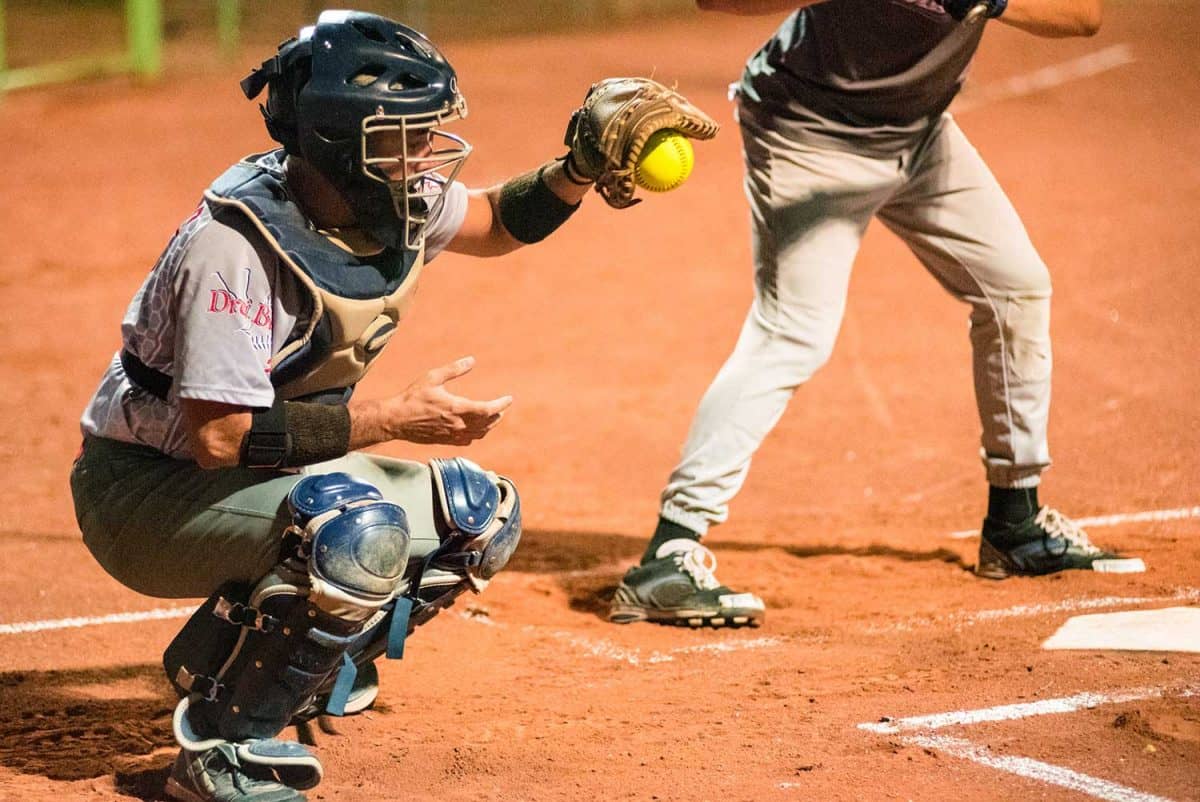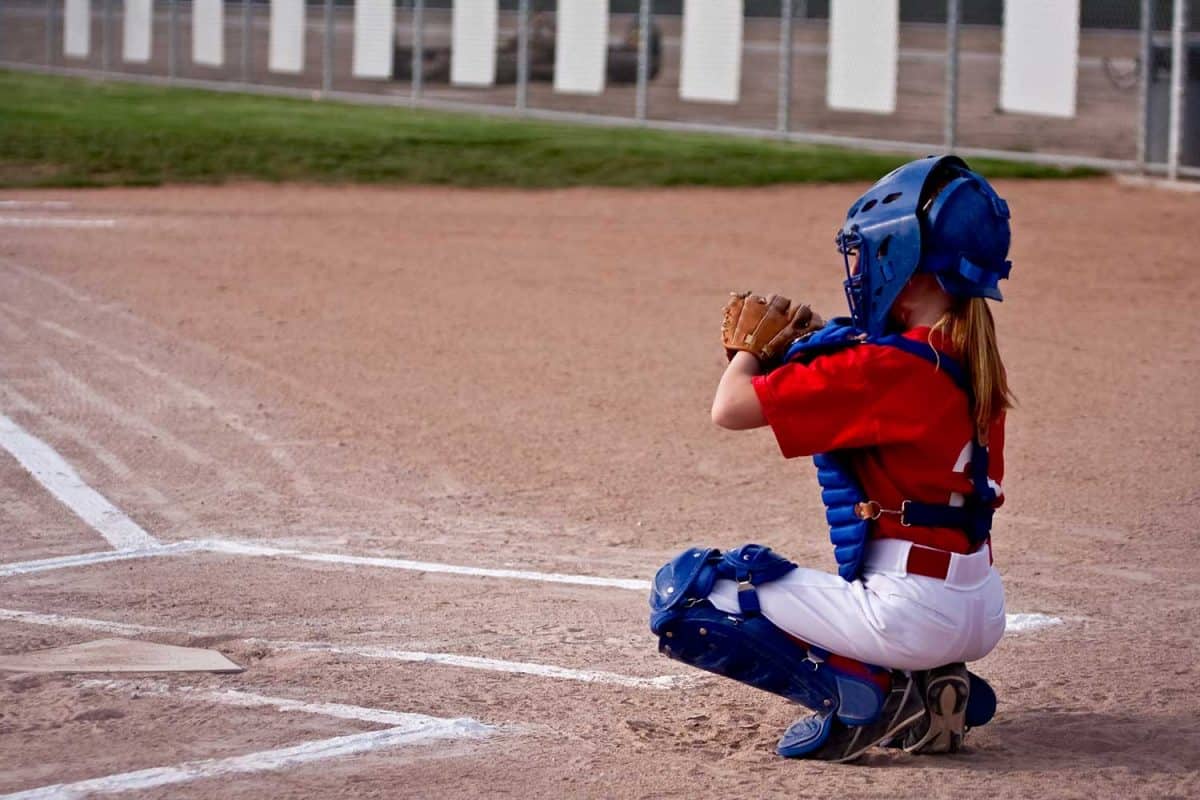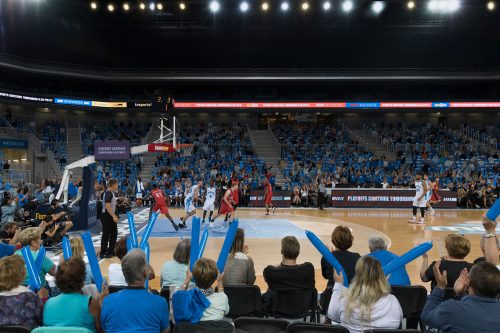Softball is one of the most exciting sports that is also great for your health! There are nine different positions that you could play on the field. One of the most popular positions in softball is the catcher. You might be wondering, is it hard to be a softball catcher? Don't worry; we have all of the answers that you need.
The catcher position in softball can either be the easiest position to play or the hardest; it all depends on what type of softball you are playing. If you are playing slow-pitch softball, the catcher position is quite simple and easy-going. However, if you are playing fast-pitch softball, the catcher position is incredibly challenging and demanding. Either way, the catcher in softball must be prepared to face some bruises and scars, as the game is often demanding.
Keep reading to learn more about the ease/difficulty of playing the catcher position in softball, what makes a good softball catcher, how to be a better softball catcher, and information on what position is the hardest in softball.

Is Being a Softball Catcher Hard?
Although it may not look like a difficult position, the catcher position in softball is more complicated than it seems. If you want to be the catcher, you have to be prepared to get hit in the face by foul balls and strikes. Although you do get to wear hefty protective gear, getting hit in the face with a ball still hurts.
You will also have to get used to crouching down in a squat for an extended time. Most catchers will squat for 2-5 hours to complete a full game. This can be very uncomfortable, especially for players who are new to the position. As the catcher, you will be responsible for catching the ball, no matter what. You'll have to slide through the dirt. You may even run into other players as they are running to the home base.

In addition to being physically difficult, you have to be mentally alert to be a good catcher. You must have a great understanding of the game and always know what is going on. Often, the players in the outfield are distracted or unaware of what is happening. The catcher is in charge of communicating with players in the outfield to tell them directions and plays. The catcher's responsibility is to keep the game on track and stay aware of the score, line-up, the number of outs, and the type of balls that the pitcher is throwing.
As mentioned above, the difficulty and ease of pitching in a softball game depend on the form of softball that is played: slow-pitch vs. fast-pitch softball.
Slow-Pitch Softball
In slow-pitch softball, the catcher position is the easiest on the field. This is because the balls are moving incredibly slow and are very easy to catch. Some leagues do not even require protective equipment beyond a mask for slow-pitch catchers. A slow-pitch catcher must be able to catch the ball and have enough strength to throw it back to the pitcher, but beyond that, their job is pretty easy.
Fast-Pitch Softball
The catcher's role in fast-pitch softball, however, is an entirely different story. In fast-pitch softball, the position of catcher is known as one of the most difficult. The ball is thrown to the plate at an incredible speed, making it difficult and often painful to catch. The game is played faster, causing an increased amount of pressure on the catcher. This position takes a great deal of mental and physical strength, as well as great judgment on the field.
What Makes A Good Softball Catcher?
Now that you know about the difficulty of the catching position in softball, you may be wondering what qualities make up a good catcher. The number one quality of a good catcher is leadership skills. Although it doesn't look like it on the surface, the catcher carries the team. They are responsible for defense and communicating quick decisions, and softball plays with the rest of the team. The catcher must also keep up the optimism of the team, especially of the pitcher. Because of this, a good catcher must also be a strong leader.
A good catcher should also be quick and agile, especially in fast-pitch softball. Nothing is worse than a catcher who moves too slowly to catch the ball! You must be able to get to it as quickly as possible, decide where to throw it, and complete the pass with ease. If the catcher misses the ball or a foul is hit, they must be prepared to sprint to retrieve the ball. If you don't like to run, you should not sign up for this position!
How To Be A Better Softball Catcher

Practice
Practice makes perfect! A catcher can never get enough practice in fielding the ball. A catcher needs to have quick footwork to ensure that the ball gets where it needs to go on the field. It is important to practice different drills and plays often if you want to improve your catching on the field!
Know your pitcher!
The catcher in softball has to have a great connection with the pitcher to guess their every move. A great catcher can sense problems that the pitcher may have to decide when she/he needs to walk to the mound to have a quick talk. The catcher should always make communication with the pitcher a priority!
Have the appropriate equipment
The equipment also plays a significant role in the success of the catcher. If you are playing slow-pitch softball, any catching glove will do. If you are playing fast-pitch softball, you want to make sure that you have an appropriate glove. The best glove for fast-pitch softball has some extra padding and is made out of soft leather. This way, the catcher won't get hurt and bruise as easily and will be able to move the ball more quickly.
Perfect Your Stance
The catcher's stance might be the most critical factor for their success on the field! The stance differs from position-to-position, making it hard to master. However, the catcher must always be crouched into a squat, with their legs solid and ready to jump and run if needed. Their glove must always be open, with the thumb forward and the fingers back, so that the pitcher has a large target to aim for.
What Is The Hardest Position To Play In Softball?
Which position is the hardest in softball? The answer to this is very debatable, as every position has its own difficulties! However, the most difficult positions are catcher, pitcher, and shortstop. We already told you about the catcher position's hardships, so we'll focus more on the pitcher and the shortstop in this section.
Pitcher
The pitcher position is the most high-stress position on the softball team. They have to stand on the mound and block out the fans' gaze and attention, knowing that their every move is being watched and judged. They also have to deal with pushback when they throw the perfect pitch - that ends up being hit as a home run by the other team!
The pitcher position is also physically demanding. Accuracy is a must. To be a good pitcher, you must spend countless hours mastering different pitching techniques. You must have a good understanding of physics on the field to ensure that your throws are accurate.
Shortstop
The shortstop is positioned between the second and third bases and responsible for any balls that land in this area. This isn't easy because most balls do end up landing in this area! Because of this, the shortstop must always be on high alert. If they get distracted even for a second, it could cost the team the game. Shortstop must be ready to field any balls that come to them. This requires great responsibility and quick decision-making skills.
Final Thoughts
No matter what position you play, softball is a physically and mentally demanding sport. You will always be on high alert, and you must be agile and quick. If you are the catcher, you should be prepared to squat in uncomfortable positions for hours on end and always be ready to jump, run, and throw. Although softball is difficult, it is definitely on the best sports to play. As always, stay hydrated, stay safe, and have fun!





![Read more about the article How To Bake A Bowling Ball [And Why]](https://fitseer.com/wp-content/uploads/2022/05/Bowling-strike-hit-with-fire-explosion-1-500x333.jpg)
![Read more about the article How To Add Grip To Basketball Shoes [5 Crucial Tips]](https://fitseer.com/wp-content/uploads/2020/09/A-high-school-basketball-player-dribbles-between-his-legs-with-his-basketball-shoes-grips-on-the-floor-500x333.jpg)